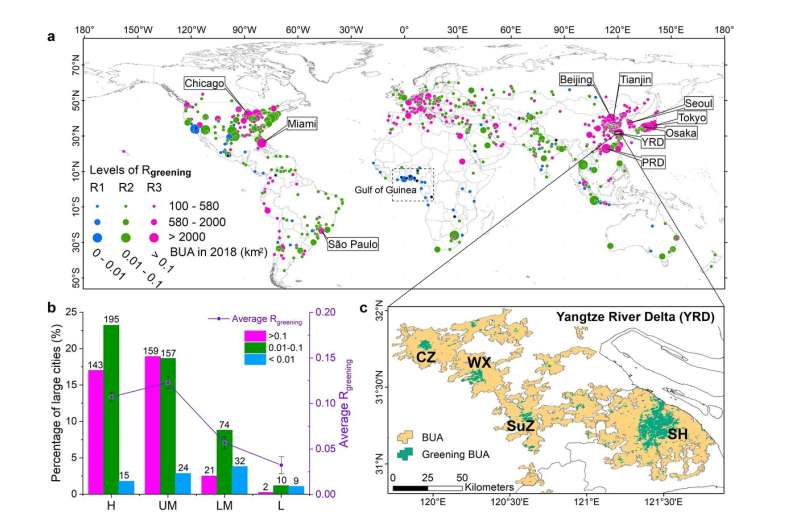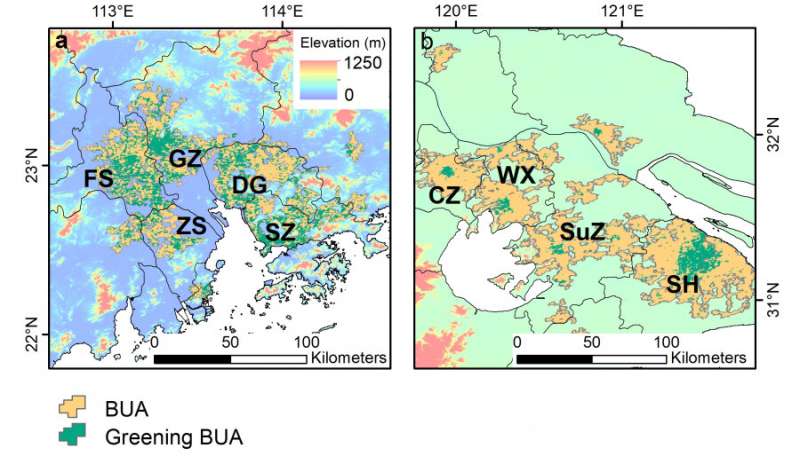First global study shows uneven urbanization among large cities in the last two decades

The world has experienced dramatic urbanization in recent decades. According to the latest report from the United Nations (UN), the global population in 2018 was 7.6 billion and the urban population was 4.2 billion. By 2050, the global population is expected to soar to 9.7 billion, with 68% of the population living in urban areas.
In the first-ever study on the characteristics of urbanization in large cities around the world, researchers at the Department of Civil Engineering of the University of Hong Kong (HKU) analyzed cities' urban built-up areas (BUAs) expansion, population growth and greening BUA changes, and revealed a hugely uneven pace of urbanization in those cities in the last two decades. They warn against major challenges posed to sustainable development if the urban problems are not dealt with in a timely manner. The findings have been published in Nature Communications.
The study, conducted by Professor CHEN Ji at the Civil Engineering Department of the Faculty of Engineering, HKU, in collaboration with the Shenzhen Institute of Advanced Technology, Chinese Academy of Sciences, and National Supercomputing Center in Shenzhen, analyzed the development of 841 large cities throughout the world with BUAs of over 100 km2 based on MODIS satellite data from 2001 to 2018 obtained under the International Geosphere-Biosphere Programme.
Breakdown of the 841 large cities by country income-levels
- 353 cities (42.0%) from high-income countries (e.g. New York in the US, Tokyo in Japan)
- 340 cities (40.4%) from upper-middle-income countries (e.g. Pearl River Delta (PRD) and Beijing in China, Sao Paulo in Brazil)
- 127 cities (15.1%) from lower-middle-income countries (e.g. New Delhi in India, Cairo in Egypt, Lagos in Nigeria)
- 21 cities (2.5%) from low-income countries (e.g. Kathmandu in Nepal, Dar es Salaam in Tanzania)
The findings revealed unevenness between built-up areas expansion (BUAE), which reflects the pace of infrastructure development, and urban population growth among the cities; and a widening gap between rapid urban population growth and slow urban greening, represented by features including new parks, green spaces and green roofs.

Cities in the upper-middle-income countries demonstrated the highest BUA expansion, which was more than three times that of high-income countries. Urban expansion and urban population growth in high-income countries remained the lowest. Cities in the low-income and lower-middle-income countries had the highest urban population growth on average, but were substantially lagging behind in BUA expansion and infrastructure development, resulting in serious urban problems such as slums and crowding.
The findings also revealed rapid urbanization of large cities in China in the last two decades. The country had undergone the biggest urban expansion in the period, between 2001 and 2018, its BUA increase accounted for 47.5% of the total expansion in the world. In 2018, the country has 19% of the total BUA of large cities in the world.
"Due to the rapid economic growth in the study period, China invested a large amount of resources into infrastructure construction for advancing the urban living environment. Its progress in greening has been impressive, benefitting at least 108 million city dwellers, accounting for 32% of the total greening at BUAs in the large cities over the world," Professor Chen said.
Of the 841 cities studied, 325 showed significant greening with more than 10% of greening BUAs. Among them 101 are located in China. The largest greening BUAs are Pearl River Delta (PRD), Tokyo, Yangtze River Delta (YRD), Miami, Beijing, Chicago, Seoul, Tianjin, Sao Paulo, and Osaka. In 2018, cities in the highest quarter of greenness range accommodated only 12% of the total city population; about 69% of the total population lived in areas with a lower greenness.
"China will reach carbon emission peak before 2030 and carbon neutrality by 2060, and large cities with a significant greening trend play an important role in neutralizing carbon emission and mitigating the impact of global climate change in urban areas. For the majority of the developing countries, understanding the uneven urbanization in the past decades can provide scientific references for urban management, helping to strike a balance between urbanization, population growth and environmental changes," Professor Chen said.
"Our research provides a low-cost method for monitoring sustainable urban development globally, and the quantitative findings contribute to a better understanding of how to achieve rational urbanization and sustainable development in various cities. The findings also serve as a warning that continuing and rapid urban development without proper and long-term planning can be detrimental and the urgent need is to strengthen urban planning and governance, especially in developing and least developed countries," Professor Chen added.
More information: Liqun Sun et al, Dramatic uneven urbanization of large cities throughout the world in recent decades, Nature Communications (2020). DOI: 10.1038/s41467-020-19158-1
Journal information: Nature Communications
Provided by The University of Hong Kong




















